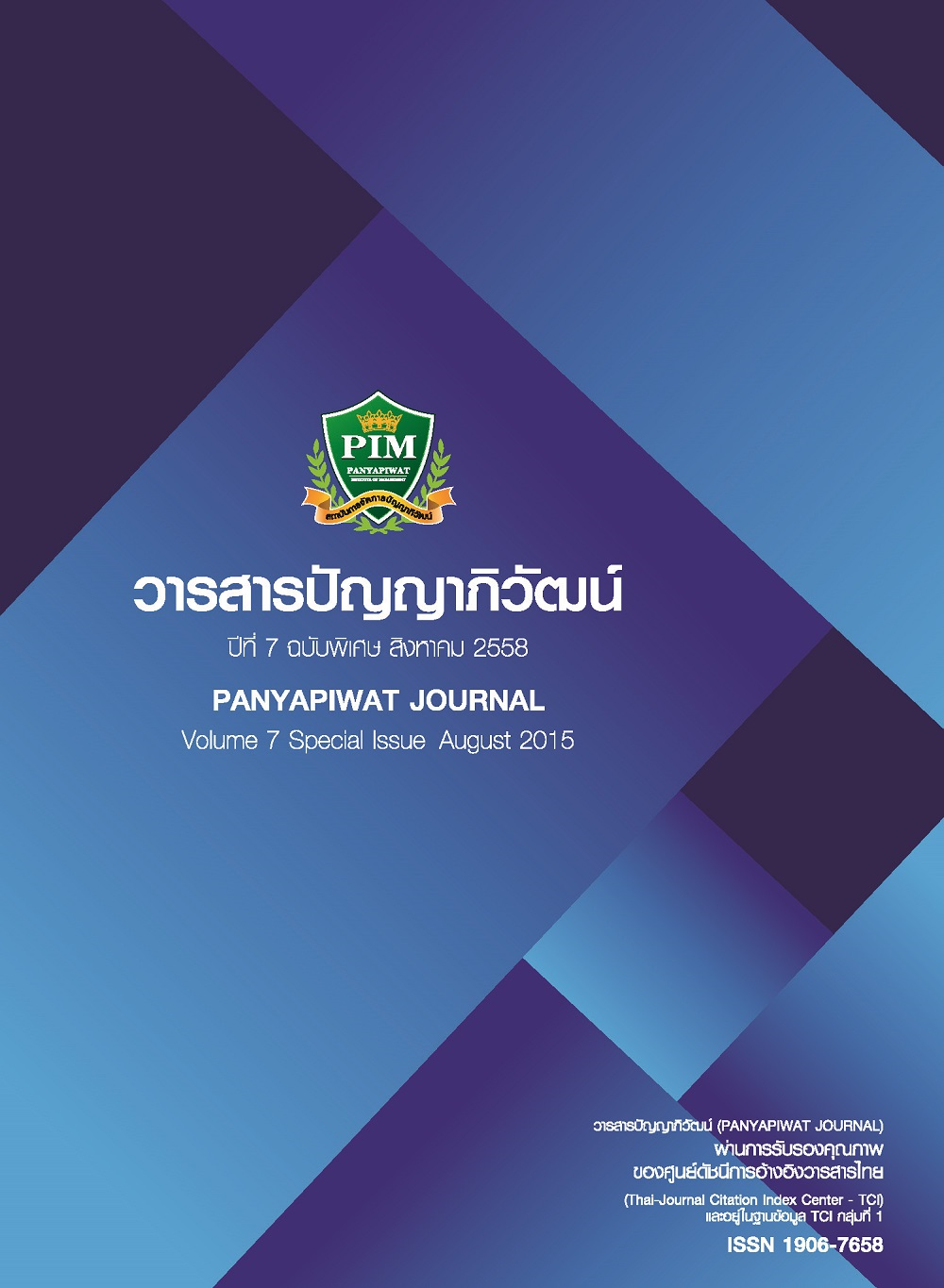ระบบสารสนเทศเพื่อการจัดการ สำหรับการบริหารสถาบันอุดมศึกษา ที่เป็นการศึกษาอิเล็กทรอนิกส์
Main Article Content
บทคัดย่อ
การบริหารสถาบันอุดมศึกษาที่เป็นอยู่ในปัจจุบัน ได้นำระบบและกระบวนการการศึกษาอิเล็กทรอนิกส์ (e-Education) ซึ่งเป็นเทคโนโลยีที่สนับสนุนให้การจัดระบบการศึกษา (Education system) ทำงานอย่างเป็นขั้นตอนบนระบบเครือข่าย ก่อให้เกิดการพัฒนารูปแบบการบริหารจัดการศึกษาใหม่ๆ อย่างต่อเนื่อง สำหรับระบบสารสนเทศเพื่อการจัดการ (Management information systems: MIS) เป็นระบบที่ให้ข้อมูลหรือระบบสารสนเทศที่สัมพันธ์กับการดำเนินงานขององค์กร ซึ่งมีการนำมาใช้เพื่อช่วยเหลือในด้านการบริหารจัดการศึกษา ตามที่ระบุไว้ในกรอบนโยบายเทคโนโลยีสารสนเทศระยะ พ.ศ. 2544-2553 เป็นต้นมา โดยมีเป้าหมายในการ พัฒนาและเตรียมความพร้อมด้านทรัพยากรมนุษย์ในทุกระดับของประเทศ เพื่อรองรับการพัฒนาสู่การเป็นสังคมแห่งภูมิปัญญาและการเรียนรู้ ดังนั้น ในการศึกษาอิเล็กทรอนิกส์ (e-Education) จึงนำเทคโนโลยีสารสนเทศและการสื่อสารมาใช้เป็นเครื่องมือในการบริหารจัดการศึกษาทั้งระบบ เริ่มตั้งแต่กระบวนการสรรหาบุคลากรของสถาบันการศึกษา กระบวนการรับนักศึกษา งานทะเบียนและวัดผล งานหลักสูตรและการสอน งานห้องสมุด งานแนะแนว งานวิจัยและพัฒนา งานกิจการนักศึกษา การจัดการความรู้ ระบบสารสนเทศเพื่อผู้บริหารสถาบันการศึกษา งานอาคารสถานที่ งานสวัสดิการและสิ่งอำนวยความสะดวก เป็นต้น อันเป็นประโยชน์ต่อการพัฒนาคุณภาพการศึกษาในปัจจุบัน สำหรับการใช้ประโยชน์จากระบบสารสนเทศเพื่อการจัดการนี้ ต้องคำนึงถึง 1) ความถูกต้องแม่นยำ (Accurate) ของการรวบรวมข้อมูล 2) ความสมบูรณ์ครบถ้วน (Complete) ของเนื้อหา 3) ความเข้าใจง่าย (Simple) ไม่ซ้ำซ้อนในการทำความเข้าใจ 4) ความน่าเชื่อถือ (Reliable) ของวิธีการรวบรวมข้อมูลที่นำเข้าสู่ระบบ 5) การตรวจสอบได้ (Verifiable) คือ ต้องตรวจสอบความถูกต้องได้ 6) ความยืดหยุ่น(Flexible) ในการนำไปใช้ตามวัตถุประสงค์ที่แตกต่างกันหลายๆ ด้าน และ 7) ความสะดวกในการเข้าถึง(Accessible) โดยกำหนดการเข้าถึงข้อมูลตามระดับสิทธิของผู้ใช้
ในการออกแบบและการใช้เทคโนโลยีสารสนเทศเพื่อการบริหารสถาบันอุดมศึกษาอย่างมีประสิทธิภาพและประสิทธิผลนั้น ควรเข้าใจระบบโครงสร้างการทำงานภายในของสถาบันการศึกษา บทบาทของผู้บริหารและกระบวนการตัดสินใจของสถาบันอย่างถ่องแท้ นักบริหารการศึกษาที่ทันสมัย จะพึ่งพาเทคโนโลยีสารสนเทศในฐานะเครื่องมือที่จำเป็นสำหรับการนำข้อมูลซึ่งผ่านการสรุปรวบยอด หรือก็คือ ข้อมูลในระดับยอดพีระมิดที่ประมวลผลอย่างมีระเบียบแบบแผน ไปใช้เป็นทางเลือกในการตัดสินใจทั้งเชิงนโยบายและเชิงยุทธศาสตร์ตามพันธกิจ 4 ด้าน คือ การเรียน การสอน การวิจัย การบริการวิชาการ และการทำนุบำรุงศิลปวัฒนธรรมให้เป็นไปตามกรอบแนวคิดทักษะการเรียนรู้ในศตวรรษที่ 21 และการบริหารจัดการศึกษาที่ก้าวสู่ความเป็นประชาคมอาเซียน
Management of higher Education has recently implied E-education which is the technology that play role to support Education System. The E-Education operates on the network infrastructure integrating information and communication technology to contribute digital learning material continuously as educational management tool for all education system.
Management information system (MIS) also provides information and operating information that relating to operation of the organization, such as MIS for education management. According to Thailand Information and Communication technology (ICT) framework (Year 2001-2010) aims at MIS to support and create new innovation for education system which consist of the recruitment process, admission process, registration and measurement, curriculum and instruction, Library database, Guidance, research and development, a student affairs, Knowledge management, information system for administrator, buildings and facilities management, Welfare and etc. Utilizing the effectively ICT, the developer should advert theses consequences of 1) Accuracy of Data 2) Complete of content 3) Simple to understand 4) Reliable method of gathering information. 5) Verifiable; the information must be checked for accuracy 6) Flexible; information must be able to used in many different purpose 7) Accessible by different based user levels.
The development of Effective and Efficiency MIS for E-learning must recognized the structure, functions and roles within the educational organization including executive role and decision making system. However information technology system is developing continuously and suitable for new education administrations. The User should use information technology system as an information tool which the data has been conceptualized or aggregated in a pyramid data model orderly. These data would be the supportive information for alternative decision making for strategic and policy management accordingly to the Thailand 4 Education plan’s mission; Teaching, Academic Research, Academic Service to community, Promote national Art and Culture and also in conjunction with Education Management plan entering the ASEAN.
Article Details
“ข้าพเจ้าและผู้เขียนร่วม (ถ้ามี) ขอรับรองว่า บทความที่เสนอมานี้ยังไม่เคยได้รับการตีพิมพ์และไม่ได้อยู่ระหว่างกระบวนการพิจารณาลงตีพิมพ์ในวารสารหรือแหล่งเผยแพร่อื่นใด ข้าพเจ้าและผู้เขียนร่วมยอมรับหลักเกณฑ์การพิจารณาต้นฉบับ ทั้งยินยอมให้กองบรรณาธิการมีสิทธิ์พิจารณาและตรวจแก้ต้นฉบับได้ตามที่เห็นสมควร พร้อมนี้ขอมอบลิขสิทธิ์บทความที่ได้รับการตีพิมพ์ให้แก่สถาบันการจัดการปัญญาภิวัฒน์หากมีการฟ้องร้องเรื่องการละเมิดลิขสิทธิ์เกี่ยวกับภาพ กราฟ ข้อความส่วนใดส่วนหนึ่งและ/หรือข้อคิดเห็นที่ปรากฏในบทความข้าพเจ้าและผู้เขียนร่วมยินยอมรับผิดชอบแต่เพียงฝ่ายเดียว”
เอกสารอ้างอิง
กระทรวงศึกษาธิการ. (2552). พระราชบัญญัติการศึกษาแห่งชาติ พ.ศ.2542.สืบค้นเมื่อ 23 กุมภาพันธ์ 2558, จาก www.moe.go.th/main2/plan/p-r-b42-01.htm
พรรณี สวนเพลง. (2552).เทคโนโลยีสารสนเทศและนวัตกรรมสำหรับการจัดการความรู้.มหาวิทยาลัยราชภัฎสวนสุนันทา.
ทวีศักดิ์ กออนันตกูล. (2551). The Internet in Thailand: Our Milestones. สืบค้นเมื่อ 2 เมษายน 2558, จาก http://www.nectec.or.th
วรพจน์ นวลสกุล. (2555).ประเภทและคุณลักษณะของสารสนเทศ. กรุงเทพฯ.
สุชาดา กีระนันทน์ (2541). เทคโนโลยีสารสนเทศ: สถิติ ข้อมูลในระบบสารสนเทศ. กรุงเทพฯ: โรงพิมพ์จุฬาลงกรณ์มหาวิทยาลัย.
สุภาพร เพียรดี. (2551). ระบบสารสนเทศเพื่อการบริหารช่วยพัฒนาองค์กรได้อย่างไร. สืบค้นเมื่อ 10 กรกฎาคม 2558, จาก http://www.gotoknow.org/posts/429139
อุทัย บุญประเสริฐ. (2552). วิจัยสถาบันกับการบริหารในสถานศึกษา: การวิจัยด้านการจัดการการศึกษา. ศูนย์วิจัยมหาวิทยาลัยธุรกิจบัณฑิตย์.
Galliers R. D. & Leidner D. E. (2003). Strategic Information Management: Challenges and Strategies in Management Information Systems. (3th ed.). Great Britain: Butterworth-Heinemann.
Kowalski, T. J. (2003). Contemporary School Administration. Boston: Pearson Education.
Lockard, J. & Abrams, P. D. (2004). Computers for Twenty-First Century Education. (6th ed.).Boston: Pearson Education.
Thierauf, R. J. (1991). Executive Information System: A Guide for Senior Management and MIS Professionals. Quorum Books.
Translated Thai References
Boonprasert, U. (2009). Institute Research and Administration in the Educational Institute: the Research of Educational Management. The Research Center of Dhurakij Pundit University. [in Thai]
Keeranun, S. (1998). Information Technology: Statistics and Information System Data. Bangkok: Chulalongkorn Publishing. [in Thai]
Koranantakul, T. (2008). The Internet in Thailand: Our Milestones. Retrieved April 2, 2015 from http://www.nectec.or.th [in Thai]
Ministry of Education. (2009). The National Education Act 1999. Retrieved February 23, 2015, from www.moe.go.th/main2/plan/p-r-b42-01.htm [in Thai]
Nuansakul, V. (2011). Types and Characteristic of Information. Bangkok.
Piandee, S. (2008). How does the Information Technology for Management develop the Organization?.Retrieved July 10, 2015, from http://www.gotoknow.org/posts/429139 [in Thai]
Suanpleng, P. (2009). Information Technology and Innovation for Knowledge Management.Suan Sunandha Rajabhat University. [in Thai]


